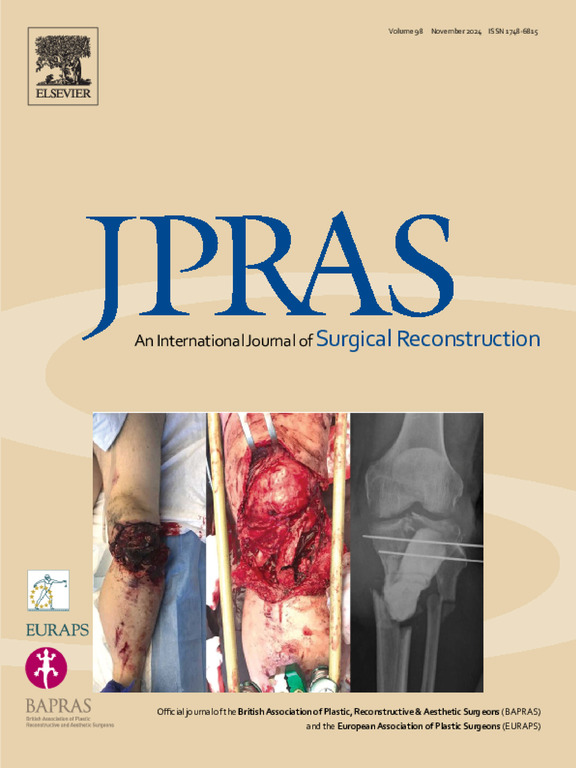Extracorporeal shockwave therapy improves post-breast reconstruction fibrosis: A randomized controlled blinded clinical trial
IF 2.4
3区 医学
Q2 SURGERY
Journal of Plastic Reconstructive and Aesthetic Surgery
Pub Date : 2025-09-09
DOI:10.1016/j.bjps.2025.08.045
引用次数: 0
Abstract
Background
Fibrosis following breast reconstruction is a debilitating syndrome characterized by (1) restricted shoulder and upper extremity mobility, (2) chronic pain and discomfort, (3) poor tissue pliability, and (4) suboptimal aesthetic outcomes. This condition significantly impairs the quality of life and functional recovery. Currently, no therapeutics directly target fibrotic remodeling. Extracorporeal shockwave therapy (ESWT) uses targeted acoustic pulses to stimulate cellular regeneration, collagen remodeling, and tissue softening, and may offer a novel non-invasive intervention.
Methods
A single-blinded randomized controlled clinical trial was conducted in 40 adult women with clinically diagnosed postoperative fibrosis following breast reconstruction. Participants were randomized to receive either ESWT or sham treatment, delivered in eight biweekly sessions over four weeks, with follow-up at three months. The primary outcome was patient-reported breast softness. Secondary outcomes included pain, fibrosis size, shoulder mobility, observer assessments, and ultrasound-based tissue quality.
Results
Compared to the placebo group, the ESWT group demonstrated significantly greater improvements in breast softness (mean change: 4.92 ± 1.86 vs. 0.9 ± 1.48; p = 0.00003), pain (−2.00 ± 2.28 vs. +0.43 ± 2.16; p = 0.0052), and fibrosis size (3.88 ± 1.82 vs. 0.86 ± 1.59; p = 0.0015). Observer-rated outcomes also favored the treatment, including breast firmness (−2.12 ± 1.55 vs. −0.14 ± 1.77; p = 0.0013) and overall opinion (−2.04 ± 1.78 vs. −0.43 ± 1.74; p = 0.0003). Ultrasound scores improved across all metrics, including fibrosis depth (1.08 ± 0.74 vs. 0.57 ± 0.51; p = 1.57 × 10⁻⁵) and boundary definition (1.23 ± 0.65 vs. 0.29 ± 0.47; p = 5.30 × 10⁻⁵).
Conclusion
ESWT significantly improved pain, softness, lesion size, and sonographic fibrosis features in patients with post-reconstruction fibrosis, demonstrating strong and sustained therapeutic benefit.
Clinical trial registration
NCT06919042
体外冲击波治疗改善乳房重建后纤维化:一项随机对照盲法临床试验。
背景:乳房重建后的纤维化是一种衰弱综合征,其特征为:(1)肩部和上肢活动受限,(2)慢性疼痛和不适,(3)组织柔韧性差,(4)美学效果欠佳。这种情况严重影响生活质量和功能恢复。目前,没有治疗方法直接针对纤维化重塑。体外冲击波疗法(ESWT)使用有针对性的声脉冲来刺激细胞再生、胶原重塑和组织软化,可能提供一种新的非侵入性干预。方法:对40例经临床诊断为乳房重建术后纤维化的成年女性进行单盲随机对照临床试验。参与者被随机分配接受ESWT或假治疗,在四周内进行8次双周治疗,随访3个月。主要结果是患者报告的乳房柔软度。次要结局包括疼痛、纤维化大小、肩关节活动度、观察者评估和基于超声的组织质量。结果:与安慰剂组相比,ESWT组在乳房柔软度(平均变化:4.92±1.86比0.9±1.48,p = 0.00003)、疼痛(-2.00±2.28比+0.43±2.16,p = 0.0052)和纤维化大小(3.88±1.82比0.86±1.59,p = 0.0015)方面均有显著改善。观察者评价的结果也有利于治疗,包括乳房坚固度(-2.12±1.55比-0.14±1.77,p = 0.0013)和总体意见(-2.04±1.78比-0.43±1.74,p = 0.0003)。超声评分在所有指标上都有所提高,包括纤维化深度(1.08±0.74 vs 0.57±0.51;p = 1.57 × 10⁻)和边界定义(1.23±0.65 vs 0.29±0.47;p = 5.30 × 10⁻)。结论:ESWT可显著改善重建后纤维化患者的疼痛、柔软度、病变大小和超声纤维化特征,显示出强大且持续的治疗效果。临床试验注册:NCT06919042。
本文章由计算机程序翻译,如有差异,请以英文原文为准。
求助全文
约1分钟内获得全文
求助全文
来源期刊
CiteScore
3.10
自引率
11.10%
发文量
578
审稿时长
3.5 months
期刊介绍:
JPRAS An International Journal of Surgical Reconstruction is one of the world''s leading international journals, covering all the reconstructive and aesthetic aspects of plastic surgery.
The journal presents the latest surgical procedures with audit and outcome studies of new and established techniques in plastic surgery including: cleft lip and palate and other heads and neck surgery, hand surgery, lower limb trauma, burns, skin cancer, breast surgery and aesthetic surgery.

 求助内容:
求助内容: 应助结果提醒方式:
应助结果提醒方式:


